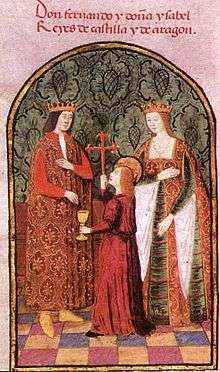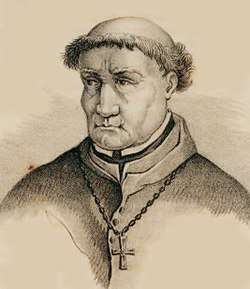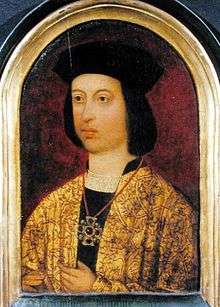Expulsion of Jews from Spain
Following the Alhambra Decree in 1492,[1] to eliminate their influence on Spain's large converso population and ensure its members did not revert to Judaism, many Jews in Spain either converted or were expelled. Over half of Spain's Jews had converted to Catholicism as a result of the religious persecution and pogroms in 1391.[2] Due to continuing attacks, around 50,000 more had converted by 1415.[3] Those who remained chose to convert to avoid expulsion. As a result of the Alhambra decree and the prior persecution, over 200,000 Jews converted to Catholicism and between 40,000 and 100,000 were expelled. An unknown number returned to Spain in the following years.[4]:17 This led to Mass migration of Jews from Spain to Italy, Greece and the Mediterranean Basin.[5] This can be seen with Jewish surnames as they began to show up in Italy and Greece at this time, like Faraggi, Farag and Farachi a surname which originates from the Spanish City of Fraga.[6]
The edict was formally and symbolically revoked on 16 December 1968,[7] following the Second Vatican Council. This occurred a full century after Jews had openly begun to practice their religion in Spain and synagogues were once more legal places of worship under Spain's Laws of Religious Freedom.
In 1924, the regime of Miguel Primo de Rivera granted Spanish citizenship to the entire Sephardic Jewish diaspora. In 2014, the government of Spain passed a law allowing dual citizenship to Jewish descendants, to "compensate for shameful events in the country's past."[8] Thus, Sephardi Jews who can prove they are the descendants of the Jews expelled from Spain as a result of the Alhambra Decree can "become Spaniards without leaving home or giving up their present nationality."[9][10]
In 2015 the Spanish Parliament passed a law recognizing the descendants of the Jews expelled in 1492 as Spanish Citizens; this decision was, however, halted in October 1, 2019.[11]
Background
Jews in the peninsular medieval Christian states
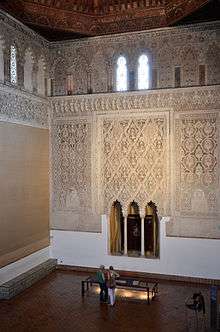
Until the fourteenth century, Jews who lived under the Muslim caliphates of Al-Andalus were tolerated. Scholar María Rosa Menocal wrote that Jews under Muslim rule were dhimmis with reduced rights relative to Muslims, but were still generally in a better position than European Jews who lived under Christian rule. Others, such as historians Bernard Lewis, Darío Fernández-Morera, and Mark R. Cohen, have suggested the supposed harmony between Jews and Muslims in Spain was an exaggeration started in the 19th century.[12][13][14]
On January 2, 1492, the Catholic Monarchs conquered the Nasrid Kingdom of Granada. The last Muslim king, Muhammad XII of Granada (Spanish: Boabdil), withdrew to Alpujarras, as almost 800 years of Muslim rule were ended by the Reconquista.
A letter sent by the Catholic Monarchs to the Council of Bilbao in 1490 stated that under canon law and the laws of the kingdoms, Jews were tolerated and allowed to live in the kingdoms as subjects and vassals.[15] Joseph Pérez considers that "the myth of the 'Spain of the three cultures', widely used as an element of propaganda, is so far detached from historical reality that it can only generate new elements of confusion".[16] According to Henry Kamen, Jews and Muslims were treated "with contempt"[17] and the Jews were treated with disdain. Three communities "lived separate stocks."[18]
In the twelfth and thirteenth centuries, Christian anti-Judaism was reflected in the harsh anti-Jewish measures agreed in the Lateran Council called in 1215 by Pope Innocent III. The peninsular Christian kingdoms were by no means foreign to the growth of increasingly belligerent anti-Judaism—in the Castilian code of Siete Partidas it was said that the Jews lived among Christians "so that their presence would remind that they descended from those who crucified Our Lord Jesus Christ"—but the kings continued to "protect" the Jews for the important role they played in their kingdoms.[19]
In the fourteenth century, the period of relative tolerance towards the Jews was over, passing into a phase of increasing conflicts. According to Joseph Perez, "the changing times are not the mentalities, the circumstances. The good times of Spain of the three religions had coincided with a phase of territorial, demographic and economic expansion, Jews and Christians did not compete in the labor market: both one and the other contributed to the general prosperity and shared their benefits. The militant of the Church and the friars hardly found an echo. Of the fourteenth century, the wars and natural catastrophes that precede and follow the Black Plague create a new situation. ... [People] believe themselves to be the victim of a curse, punished for sins they would have committed. It invites the faithful to repent, to change their behavior, and to return to God. This is when the presence of the "deicidal people" among Christians is considered scandalous.[20]
The Jewish massacres of 1391 and their consequences
The first wave of violence against the Jews in the Iberian Peninsula occurred in the Kingdom of Navarre as a consequence of the arrival of the crusade of the shepherds across the Pyrenées in 1321. The Jewry of Pamplona and Estella were massacred. Two decades later the impact of the Black Death of 1348 provoked assaults on the juderías of several places, especially those of Barcelona and other places in the Principality of Catalonia. In the Crown of Castile anti-Jewish violence was closely related to the civil war, during the reign of Pedro I, in which the side that supported Enrique de Trastámara used anti-Judaism as a propaganda weapon, and the pretender accused his stepbrother, Peter of Castile, of favoring the Jews. The first slaughter of Jews, in Toledo in 1355, was carried out by the supporters of Enrique de Trastámara when they entered the city. The same happened eleven years later when they occupied Briviesca. In Burgos, Jews who could not pay the large tribute imposed on them were enslaved and sold in 1366. In 1367 in Valladolid Jews were assaulted to the shout of "Long live King Henry!". There were no deaths, but the synagogues were burned down.[21]
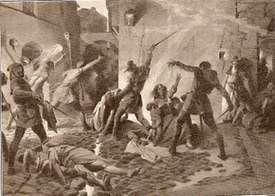
The great catastrophe for the Jews of the Iberian Peninsula took place in 1391 with massacres in the juderías of Castile and of the Crown of Aragon. The assaults, the fires, the looting, and the massacres began in June, in Seville, where Ferrand Martinez, archdeacon of Écija, took advantage of the power vacuum created by the death of the archbishop of Seville. Hardened by his preaching against the Jews, which had begun in 1378, he ordered the overthrow of the synagogues and requisitioning of prayer books. In January 1391, the first attempted assault on the Jewish quarter was avoided by the municipal authorities. However, in June 1391, hundreds of Jews were murdered, their houses ransacked, and the synagogues converted into churches. Some Jews managed to escape; others, terrified, asked to be baptized.[22][23]
From Seville, anti-Jewish violence extended throughout Andalusia, and then towards Castile. In August it reached the Crown of Aragon. Murders, looting and fires took place everywhere. Many of the Jews who survived fled, many to the kingdoms of Navarre, Portugal and France, and North Africa. Others chose baptism to avoid death. The number of victims is difficult to know. About 400 Jews were murdered in Barcelona; in Valencia 250; in Lérida 68 ...[24][25]
After the massacres of 1391, anti-Jewish measures were intensified. In 1411, Castile ordered that Jews wear a red badge sewn onto their clothing. In the Crown of Aragon the possession of the Talmud was declared unlawful, and the number of synagogues per aljama was limited to one. In addition, the mendicant orders, with the support of the monarchs, intensified their campaign of proselytism, in which Valencian Vincent Ferrer played a prominent part, to convert Jews to Christianity. It was also decreed that Jews were obliged to attend three sermons every year. As a result of the massacres of 1391 and the measures that followed, by 1415, more than half of the Jews of the crowns of Castile and Aragon had renounced Mosaic law and had been baptized, including many rabbis and important members of the community.[26]
Jews in the fifteenth century
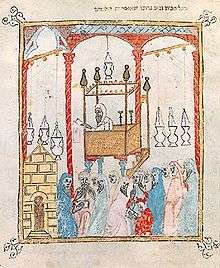
After the massacres of 1391 and the preaching that followed them, by 1415 scarcely a hundred thousand Jews continued to practice their religion in the crowns of Castile and Aragon. Joseph Perez said, "Spanish Judaism will never recover from this catastrophe." The Jewish community "came out of the crisis not only physically diminished but morally and intellectually shattered".[27]
In the Crown of Aragon, Judaism virtually disappeared in important places such as Barcelona, Valencia, and Palma—in 1424 the Barcelona Jewry was abolished because it was considered unnecessary—[28] and only the one in Zaragoza remained. In Castile, once-flourishing aljamas such as those of Seville, Toledo or Burgos lost many of their members; in 1492, the year of the expulsion, in the Crown of Aragon only a quarter of the former number of Jews remained. The famous Jewish community of Gerona, for example, was left with only 24 families. In the Crown of Castile, not 80,000 were left. In Seville before the revolts of 1391, there were about 500 Jewish families. According to Joseph Perez, at the time of the expulsion, there were fewer than 150,000 Jews, distributed in 35 aljamas of the Crown of Aragon and 216 in the Crown of Castile. In both Crowns, it was observed that the Jews had left the great cities and lived in the small and the rural areas, less exposed "to the excesses of the Christians."[29]
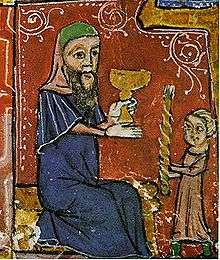
After the critical period of 1391-1415, the pressure on Jews recovering their synagogues and books confiscated decreased, and they became able to avoid certain obligations such as carrying the red ribbon or attending friars' sermons. They could also reconstruct the internal organization of the aljamas and their religious activities, thanks to the agreements reached by the procurators of the aljamas gathered in Valladolid in 1432 and sanctioned by the king, which means that "the Crown of Castile accepts again officially that a minority of its subjects has another religion than the Christian one and recognizes the right of this minority to exist legally, with a legal status." "In this way, the Jewish community is rebuilt with the approval of the crown." Abraham Beneviste, who presided over the meeting of Valladolid, was appointed court rabbi with authority over all the Jews of the kingdom, and at the same time as delegate of the king over them.[30]
During the reign of the Catholic Monarchs, in the last quarter of the 15th century, many Jews lived in rural villages and engaged in agricultural activities. Crafts and trade were not monopolized—international trade had passed into the hands of converts. While Jews continued to trade as money-lenders, the number of Christian lenders had increased a lot. Jews also continued to collect royal, ecclesiastical, and seigniorial rents, but their importance had also diminished—in Castile they were only in charge of a quarter of the revenues. However, in the court of Castile—but not in the crown of Aragon—Jews held important administrative and financial positions. Abraham Senior was from 1488 treasurer-major of the Holy Brotherhood, a key organism in the financing of the war of Grenada, and also chief rabbi of Castile. Yucé Abravanel was "A greater collector of the service and mountaineering of the herds, one of the more healthy income and greater yield of the Crown of Castile."[31] However, according to Joseph Perez, the role of the Jews in the court must not be exaggerated. "The truth was that the state could do without the Jews, both in the bureaucratic apparatus and in the management of the estate."[32]
We must, therefore, reject the claim that the Hebrew community at the end of the fifteenth century was immensely rich and influential. "In fact, the Spanish Jews at the time of their expulsion did not form a homogeneous social group. There were among them classes as in Christian society, a small minority of very rich and well-placed men, together with a mass of small people: Farmers, artisans, shopkeepers."[33] What united them was that they practiced the same faith, different from the one recognized, which made them a separate community within the monarchy and which was "property" of the crown which thereby protected them.[34] In a letter dated 7 July 1477, addressed to the authorities of Trujillo, where incidents had occurred against the Jews, Queen Isabella I of Castile, after putting the aljama under her protection and prohibiting all type of oppression or humiliation against its members, states:[35]
All the Jews of my kingdoms are mine and are under my protection, and it is for me to defend and protect them and to keep them in justice.
Thus, the Jews "formed not a State in the State, but rather a micro-society next to the majority Christian society, with an authority [the rabbi greater] that the crown delegated to him over its members." The aljamas were organized internally with a wide margin of autonomy. They designated by lottery the council of elders that governed the life of the community; collecting their own taxes for the maintenance of worship, synagogues, and rabbinical teaching; lived under the norms of Jewish law, and had their own courts that understood all cases in civil matters - from the Cortes de Madrigal of 1476 criminal cases had passed to the royal courts. But Jews did not enjoy full civil rights: they had a specific tax system far more burdensome than that of Christians and were excluded from positions that could confer authority on Christians.[36]
The situation in which the Jews lived, according to Joseph Perez, posed two problems: "as subjects and vassals of the king, the Jews had no guarantee for the future - the monarch could at any time close the autonomy of the aljamas or require new Most important taxes-"; and, above all, "in these late years of the Middle Ages, when a state of modern character is being developed, there could be no question of a problem of immense importance: was the existence of separate and autonomous communities compatible with the demands of A modern state? This was the real question."[37]
Conversos and the Inquisition
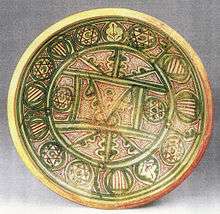
In the fifteenth century, the main problem stopped being the Jews becoming conversos who according to Henry Kamen probably numbered around three hundred thousand people. “Christian convert” was the term applied to Jews who had been baptized and their descendants. As many of them had been forcibly converted, they were often looked upon with distrust by those who considered themselves Old Christians.[38] In the fifteenth century, the positions abandoned by Jews were mostly filled by converts, who congregated where Jewish communities had flourished before 1391, doing work formerly performed by Jews - trade and crafts - with the added advantage that as Christians they could now access trades and professions previously forbidden to Jews. Some even entered the clergy, becoming canons, priors[39] and even bishops.[40]
The socio-economic position of converts was viewed with suspicion by the "old" Christians, a resentment that was accentuated by the conscience on the part of those who had a differentiated identity, proud of being Christians and having Jewish ancestry, which was the lineage of Christ. Popular revolts broke out against the converts between 1449 and 1474, a period in Castile of economic difficulties and political crisis (especially during the civil war of the reign of Henry IV). The first and largest of these revolts took place in 1449 in Toledo, during which a "Judgment-Statute" was approved that prohibited the access to the municipal positions of "no confesso of the lineage of the Jews" - an antecedent of the following blood-cleaning statutes of the following century. The origin of the revolts was economic in Andalusia especially because there was a situation of hunger, aggravated by an epidemic of plague - and in principle "not directed especially against the converts." It is the parties and the demagogues that take advantage of the exasperation of the people and direct it against the converts."[41]

To justify the attacks on converts, they affirmed that conversos were false Christians and that they still practiced the Jewish religion in secret. According to Joseph Perez, it is a proven fact that, among those who converted to escape the blind furor of the masses in 1391, or by the pressure of the proselytizing campaigns of the early fifteenth century, some clandestinely returned to their old faith when it seemed that the danger had passed, of which it is said that Judaízan. The accusation of Crypto-Judaism becomes more plausible when some cases of prominent converts who continued to observe the Jewish rites after their conversion. But Joseph Judaizers, according to Joseph Perez, were a minority, although relatively important. He also affirms Henry Kamen when he says that "it can be affirmed that in the end of the 1470s, there was no Judaizing movement highlighted or proven among the converts." He also points out that when a convert was accused of Judaizing, in many cases the "proofs" that were brought were, in fact, cultural elements of his Jewish ancestry - such as the Sabbath, not Sunday, as the day of rest - or the lack of knowledge of the new faith - such as not knowing the creed or eating meat during Lent[42]
This is how the "convergent problem" is born. The baptized can not renounce their faith according to the canonical doctrine of the Church by which Crypto-Judaism is assimilated to heresy, and as such must be punished. This is how they begin to claim various voices including those of some converts who do not want to question the sincerity of their baptism because of those "false" Christians who are beginning to be called Marrano. And it also extends the idea that the presence of the Jews among the Christians is what invites the converts to continue practicing the Law of Moses.[43]
When Isabel I of Castile ascended to the throne in 1474, she was already married to the heir to the Crown of Aragon, the future Ferdinand II of Aragon. At this time, there was no punishment for practicing crypto-Judaism, not out of tolerance for Jews, but for legalistic reasons.[lower-alpha 1] They decided to confront the "converso problem", especially after having received some alarming reports in 1475 by the Prior of the Dominicans of Seville, Friar Alonso de Ojeda[lower-alpha 2] who reported that there were a large number of conversos in that city secretly practicing their religion in private, some even doing so openly. After receiving these reports, they applied to Pope Sixtus IV for authorization to name a number of inquisitors in their kingdom, which the pontiff agreed to in his bull Exigit sincerae devotionis of 1 November 1478.[45] "With the creation of the Tribunal of the Inquisition,[lower-alpha 3] the authorities will have sufficient instruments and methods of investigation at their disposal."[46] According to Joseph Pérez, Ferdinand and Isabella "were convinced that the Inquisition would force the conversos to assimilate into society once and for all: the day when all of the new Christians would renounce Judaism, nothing would distinguish them anymore from any other member of society."[47]
Expulsion
Segregation of the Jews (1480)
From the beginning of their reign, Isabel and Ferdinand were concerned with protecting Jews - since they were "property" of the crown. For example, on September 6, 1477, in a letter addressed to the Jewish community of Seville, Queen Isabel I gave assurances about their safety:[48]
I take under my protection the Jews of the aljamas in general and to each one in particular, as well as to his people and their goods; I protect them against any attack, be it of the nature that is ...; I forbid that they attack, mate or hiera; I also prohibit a passive attitude if attacked, killed or injured.
Hence even the Catholic Kings until 1492 were reputed to be favorable to the Jews. This is what the German traveler, Nicolas de Popielovo says, for example, after his visit in 1484-1485:[49]
His subjects of Catalonia and Aragon speak publicly and the same things I have heard say to many in Spain that the Queen is protector of the Jews and daughter of a Jewish woman
But they could not do away with all the vexations and discrimination suffered by the Jews, encouraged on many occasions by the preaching of the friars from the mendicant orders. They decided to segregate the Jews to end the conflict. Already in the Cortes of Madrigal of 1476 the kings had protested the breach of the provisions in the Order of 1412 on the Jews - prohibition to wear luxury dresses; obligation to wear a red slice on the right shoulder; prohibition to hold positions with authority over Christians, to have Christian servants, to lend money at usurious interest, etc. - but in the Cortes de Toledo of 1480, they decided to go much further to fulfill these norms: to force the Jews to live in separate quarters, where they could not leave except during the day to carry out their professional occupations. Until then the Jewish quarters-where the Jews used to live and where they had their synagogues, butchers, etc.-had not formed a separate world in the cities and there were also Christians living in them and Jews living outside them. From 1480 onwards, the Jewish quarters were converted into ghettos surrounded by walls and the Jews were confined in them to avoid confusion and damage of our holy faith. A process for which a term of two years was established, but which lasted for more than ten years, and which was not exempt from problems and abuses by Christians.[50]
The text approved by the Cortes, which also included the Mudejar, read as follows:[51]
We send to the aljamas of the said Jews and Moors that each of them who put in said apartment such diligence and give such order as within the said term of the said two years have said houses of their apart, and live and die in them, and henceforth do not have their dwellings among the Christians or elsewhere outside the circuits and places that would be deputies to the said Jewry and die.
The decision of the kings approved by the Courts of Toledo, had antecedents since the Jews already had been confined in some Castilian localities like Cáceres or Soria. In this last locality had been realized with the approval of the kings "to avoid dapnos [sic] that because of bevir and to dwell and to be the Jews among the christianos they followed".[52] Fray Hernando de Talavera, confessor of the queen and who had opposed the use of force to solve the "convergent problem", also justified the segregation "by avoiding many sins, which are followed of the mixture and a great deal of familiarity [between Christians and Jews] and of not keeping everything close to their conversation with Christians by holy canons and civil laws is ordered and commanded."[53]
With the decision to detain Jews in ghettos, it was not only a question of separating them from Christians and of protecting them, but also of imposing a series of obstacles to their activities, so that they would have no choice but "to give up their status as Jews if they want to lead a normal existence. Their conversion is not demanded - not yet - nor is their autonomous statute touched, but they proceed with them in such a way that they end up convincing themselves that the only solution is conversion."[54]
The expulsion of the Jews from Andalusia (1483)

The first inquisitors appointed by the kings arrived in Seville in November 1480, "immediately sowing terror". In the first years in this city alone they pronounced 700 death sentences and more than five thousand "reconciliations" - that is, prison sentences, exile or simple penances - accompanied by confiscation of their property and disqualification or public office and ecclesiastical benefits.[55]
In their inquiries, the inquisitors discovered that for a long time many converts had met with their Jewish relatives to celebrate Jewish holidays and even attend synagogues.[56] This convinced them that they would not be able to put an end to crypto-Judaism if converts continued to maintain contact with the Jews, so they asked the kings for the Jews to be expelled from Andalusia. This request was approved and in 1483, the kings gave six months for the Jews of the dioceses of Seville, Cordoba, and Cadiz to go to Extremadura. There are doubts as to whether the order was strictly enforced since at the time of the final expulsion in 1492 some chroniclers speak of the fact that eight thousand families of Andalusia embarked in Cadiz and others in Cartagena and the ports of the Crown of Aragon. On the other hand, the expulsion of the Jews of Saragossa and Teruel was also proposed, but in the end, it was not carried out.[57]
According to Julio Valdeón, the decision to expel the Jews from Andalusia also obeyed "the desire to move them away from the border between the crown of Castile and the Nasrid Kingdom of Granada, scenario, during the eighties of the fifteenth century and the first years of the 1490s, of the war that ended with the disappearance of the last stronghold of peninsular Islam.[58]
The genesis of the expulsion decree
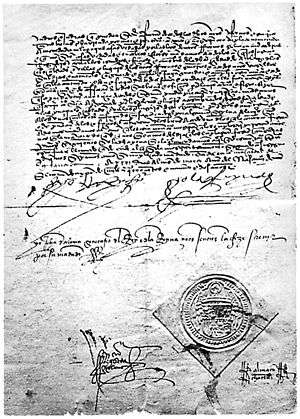
On March 31, 1492, shortly after the end of the Granada war, the Catholic Monarchs signed the decree of expulsion of the Jews in Granada, which was sent to all the cities, towns and lordships of their kingdoms with strict orders to not read it or make it public until May 1.[59] It is possible that some prominent Jews tried to nullify or soften it but did not have any success. Among these Jews stands out Isaac Abravanel, who offered King Ferdinand a considerable sum of money. According to a well-known legend when Inquisitor General Tomás de Torquemada discovered this, he presented himself before the king and threw a crucifix at his feet, saying: "Judas sold our Lord for thirty pieces of silver; His Majesty is about to sell it again for thirty thousand." According to the Israeli historian Benzion Netanyahu, quoted by Julio Valdeón, when Abravanel met with Queen Isabella, she said to him: "'Do you think this comes from me? The Lord has put that thought into the heart of the King?"[60]
A few months before an auto da fe held in Avila in which three converts and two Jews condemned by the Inquisition were burnt alive for an alleged crime of ritual crime against a Christian child (who will be known as the [Child of the Guard] contributed to create the propitious environment for the expulsion.[61]
The Catholic Monarchs had precisely entrusted to the [inquisitor general] Tomás de Torquemada and its collaborators the writing of the decree fixing to them, according to the historian Luis Suarez, three previous conditions Which would be reflected in the document: to justify the expulsion by charging Jews with two sufficiently serious offenses - usury and "heretical practice"; That there should be sufficient time for Jews to choose between baptism or exile; And that those who remained faithful to the Mosaic law could dispose of their movable and immovable property, although with the provisos established by the laws-they could not draw either gold, silver, or horses. Torquemada presented the draft decree to the monarchs on March 20, 1492, and the monarchs signed and published it in Granada on March 31. According to Joseph Perez, that the kings commissioned the drafting of the decree to Torquemada "demonstrates the leading role of [the Inquisition] in that matter."[62]
Of the decree promulgated in Granada on March 31, which was based on the draft decree of Torquemada - drawn up "with the will and consent of their altezas" and which is dated in Santa Fe On March 20 - there are two versions: One signed by the two monarchs and valid for the Crown of Castile and another signed only by King Ferdinand and valid for the Crown of Aragon. Between the draft decree of Torquemada and the two final versions and between these, they exist, according to Joseph Perez, "significant variants." In contrast to the Torquemada project and the Castilian decree, in the version addressed to the Crown of Aragon the protagonism of the Inquisition is recognized - " Persuading us the venerable father prior of Santa Cruz [Torquemada], inquisitor general of the heretical staidness usury is mentioned as one of the two crimes of which the Jews are accused: "We find the Jewish sayings, by means of great and unbearable usages, to devour and absorb the properties and substances of Christians"; We reaffirm the official position that only the Crown can decide the fate of the Jews since they are the possession of the kings - "they are ours," it is said; And contains more insulting expressions against the Jews: they are accused of making fun of the laws of Christians and of considering them idolaters; Mention is made of the abominable circumstances and of Jewish perfidy. The Judaism of "leprosy" is qualified; It is recalled that the Jews "by their own fault are subject to perpetual servitude, to be slaves and captives."[63]
Regarding the essentials, the two versions have the same structure and expose the same ideas. The first part describes the reasons why the monarchs - or the king in the case of the Aragonese version - decided to expel the Jews. The second part detailed how the expulsion would take place.[64]
The conditions of expulsion

The second part of the decree detailed the conditions for expulsion:[65]
- The expulsion of the Jews was final: "We agreed to send all Jews and Jews out of our kingdoms and never return or return to them or any of them."
- There was no exception, neither by reason of age, residence, or place of birth - it included both those born in the crowns of Castile and Aragon and those from outside.
- There was a period of four months, which would be extended ten more days, until August 10, to leave the kings' domains. Those who did not do so within that period or who returned later would be punished with the death penalty and the confiscation of their property. Likewise, those who aided or concealed the Jews were liable to lose "all their goods, vassals, and fortresses, and other inheritances."
- Within the set period of four months the Jews could sell their real estate and take the proceeds of the sale in the form of bills of exchange, not in coinage or gold and silver because their exit was prohibited by law - or merchandise - as long as they were not arms or horses, whose export was also prohibited.
Although the edict did not refer to a possible conversion, this alternative was implicit. As the historian Luis Suárez pointed out, the Jews had "four months to take the most terrible decision of their lives: to abandon their faith to be integrated in it [in the kingdom, in the political and civil community], or leave the territory in order to preserve it."[66]
The drama that the Jews lived is documented by a contemporary source:[67]
Some Jews, when the term ended, went by night and day as in despair. Many turned from the road ... and received the faith of Christ. Many others, not depriving themselves of the country where they were born and for not selling their goods at that time at lower prices, were baptized.
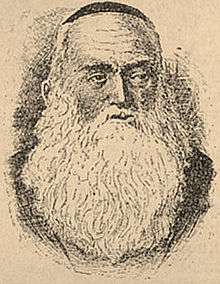
The most outstanding Jews, with few exceptions among which the one of Isaac Abravanel stands out, decided to convert to Christianity. The most relevant case was that of Abraham Senior, the chief rabbi of Castile and one of the closest collaborators of the monarchs. He and all his relatives were baptized on June 15, 1492 in the Guadalupe monastery, being his godfathers the kings Isabel and Fernando. He took the name of Fernán Núñez Coronel and his son-in-law Mayr Melamed, Fernán Pérez Coronel - the same name of pile that the one of the king. In this case, like that of Abraham de Córdoba, he was given much publicity to serve as an example for the rest of his community. In fact during the four-month tacit term that was given for the conversion many Jews were baptized, especially the rich and the most educated, and among them the vast majority of the rabbis.[68]
A chronicler of the time relates the intense propaganda campaign that unfolded:[69]
In all the synagogues and in the squares and in the churches and in the fields, by the wise men of Spain, and was preached to them by the holy gospel and the doctrine of the Holy Mother Church, and was preached and tested by their own Scriptures, how the Messiah who waited were Our Redeemer and Savior Jesus Christ, who came in the time to be agreed, which his ancestors with malice they ignored, and all the others who came after them never wanted to give ear to the truth; before being deceived by the false book of the Talmud, having the truth before their eyes and reading it in their law every day, they ignored it and ignored it.
The Jews who decided not to convert "had to prepare themselves for the march in tremendous conditions". They had to sell their goods because they had very little time and had to accept the sometimes ridiculous amounts offered to them in the form of goods that could be carried away because the gold and silver output of the kingdom was prohibited - the possibility of taking bills of exchange were not much help because the bankers, Italians for the most part, demanded enormous interest. A chronicler of the time attests this:[70]
They sold and squandered everything they could of their estates ... and in everything there were sinister ventures, and the Christians had their estates, very many and very rich houses and inheritances for few monies; and they prayed with them, and found not one to buy them, and gave a house for an ass and a vine for a little cloth or a linen cloth because they could not bring forth gold or silver.
They also had serious difficulties in recovering the money lent to Christians because either the repayment term was after August 10, deadline for their departure, or many of the debtors denounced "usury fraud", knowing that the Jews, they would not have time for the courts to prove them right.[71] In a letter to the kings, the Ampudia Jews complained that "The mayors of the said village made them and have closed many unreason and grievances says that they do not consent to them, nor do they want them to pay and pay their personal property and that they have no less, but they want to make and pay the debts owed to them and that which they deem urge them to do and then pay them even if the deadlines are not reached."[72]
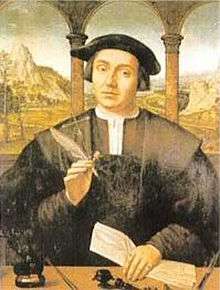
In addition, they had to pay all the expenses of the trip - transport, maintenance, freight of the ships, tolls, etc. This was organized by Isaac Abravanel, who contracted the ships, having to pay very high prices and whose owners in some cases did not fulfill the contract or killed the travelers to steal what little they had. Avranel counted on the collaboration of the real official convert Luis de Santángel and of the Genovese banker Francisco Pinelo.[73]
The monarchs had to give orders to protect Jews during the trip because they suffered vexations and abuse. This is how Andrés Bernaldez, pastor of Los Palacios, the time when the Jews had to "abandon their land of their births":[74]
All the young men and daughters who were twelve years old were married to each other, for all the females of this age above were in the shadow and company of husbands... They came out of the lands of their births, children, and children, old and young, on foot and knights on asses and other beasts, and on wagons, and continued their journeys each to the ports where they were to go; and went by the roads and fields where they went with many works and fortunes; some falling, others rising, others dying, others being born, others becoming sick, that there was no Christian that there was no pain of them and always because they were invited to baptism and some, with their care, they became and remained but very few, and the rabbis worked them up and made the women and young men sing and play tambourines.
The reasons for the expulsion
In the Castilian version reference is made exclusively to religious motives - in the Aragonese version it is also alluded to usury - because the Jews are accused of "heretical", i.e.: serve as an example and incite the convert to return to the practices of his ancient religion.
At the beginning of the decree, It is said that: It is well known that in our domains there are some bad Christians who have Judaized and have committed apostasy against the holy Catholic faith, being the cause most by the relations between Jews and Christians.[77] The following are the measures taken hitherto by kings to end the communication between the Jewish community and the converts, a fundamental cause according to the kings and the Inquisition, that the new Christians, first of all the agreement of the Cortes de Toledo of 1480 by which the Jews were forced to live in neighborhoods separated from the Christians, in order to prevent the Jews from "subverting and subtracting the Christian faithful from our holy Catholic faith." Secondly, the decision to expel the Jews from Andalusia, "believing that this would suffice for those of the other cities and towns and places of our kingdoms and lordships to cease to do and commit the aforesaid." But this measure failed" "because every day it is found and it seems that the said Jews grow in continuing their bad and damaged purpose where they live and talk.'"[78]
Finally, the reason for deciding to expel the entire Jewish community, and not just those of its members who allegedly wanted to "pervert" the Christians, is explained:[79][80]
Because when a serious and detestable crime is committed by a college or university [i.e.: a corporation and a community], it is a reason for such a college or university to be dissolved and annihilated, and the minors for the elders and the ones for the others punished and that those who pervert the good and honest living of cities and towns and by contagion can harm others to be expelled.
As highlighted Julio Valdeón, "undoubtedly the expulsion of the Jews from the Iberian site is one of the most controversial issues of all that have happened throughout the history of Spain." It is not surprising, therefore, that historians have debated whether, in addition to the motives laid out by the Catholic Monarchs in the decree, there were others. Nowadays, some of those who argued at the time, such as the expulsion of the Jews to stay with their wealth, seem to have been discarded, since the majority of the Jews who left were the most modest, while the richest converted and they stayed, and on the other hand, the crown did not benefit at all from the operation - rather it was damaged because it stopped receiving the taxes paid by the Jews. Nor does the argument seem to hold that the expulsion was an episode of classes - the nobility wanted to get rid of an incipient bourgeoisie that represented the Jews and that supposedly threatened their interests - because many Jews were defended by some of the most important nobiliary families of Castile, and because he was also among the ranks of the "bourgeoisie" of "old Christians" where anti-Judaism grew the most.[81][82]
The personal motives of the kings also seem to be ruled out, because everything indicates that they did not feel any repugnance towards Jews and converts. Among the trusted men of the kings were several who belonged to this group, such as the confessor of the queen fray Hernando de Talavera, the steward Andrés Cabrera, the treasurer of the Santa Hermandad Abraham Senior, or as Mayr Melamed or Isaac Abarbanel, without counting the Jewish doctors that attended them.[83]
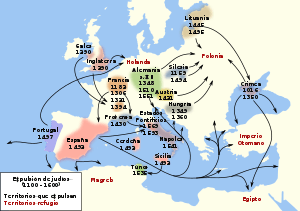
Current historians prefer to place expulsion in the European context and stand out, such as Luis Suárez Fernández or Julio Valdeón, that the Catholic Monarchs were, in fact, the last of the sovereigns of the great western European states to decree The expulsion-the Kingdom of England did it in 1290, the Kingdom of France in 1394; in 1421 the Jews are expelled from Vienna; in 1424 of Linz and of Colonia; in 1439 of Augsburg; in 1442 of Bavaria; in 1485 of Perugia; in 1486 of Vicenza; in 1488 of Parma; in 1489 of Milan and Luca; in 1493 of Sicily; in 1494 of Florence; in 1498 of Provenza...-.[84] The aim of all of them was to achieve unity of faith in their states, a principle that will be defined in the sixteenth century with the formula "cuius regio, eius religio", that the subjects should profess the same religion as their prince.[85]
As Joseph Perez pointed out, the expulsion "puts an end to an original situation in Christian Europe: that of a nation that consents to the presence of different religious communities" with which it "becomes a nation like the rest in Christendom European". "The University of Paris congratulated Spain for having carried out an act of good government, an opinion shared by the best spirits of the time (Machiavelli, Guicciardini, Pico della Mirandola)... [...] it was the so-called medieval coexistence that missed Christian Europe.[86]
Julio Valdeón affirms that the decision of the Catholic Monarchs, who "showed themselves, in their first years of rule, clearly protective of the Hebrews," was due to "pressure from the rest of Christianity" and to "the constant pressure of Church, who often preached against those he called "deicides", as well as the "tremendous animosity that existed in the Christian people against the Jewish community." In this sense, he quotes the thesis of the Israeli historian Benzion Netanyahu that the expulsion was the consequence of the climate of racism that was lived in the Christian society of the time.[87] A thesis the latter - that the kings decided the expulsion to ingratiate themselves with the masses in which the anti-Jewish sentiments predominated - that Joseph Perez considers without foundation. "Why should kings have to worry about what the masses felt about Jews and converts when they did not serve the more concrete interests of those masses?" Of the three surviving versions of the expulsion edict, only the third term "usury", which was signed only by Don Fernando, refers to the subject of usury, in very harsh terms, and in the other two versions, we do not read a single mention or even the slightest mention of this matter. Accusations that had been repeated for centuries against the Jews: people deicide, desecration of hosts, ritual crimes ... do not appear in any of the three versions."[88]
For Joseph Perez, the decision of the Catholic Monarchs, as evidenced by the content of the Granada Edict, is directly related to the "converso problem". The first step was the creation of the Inquisition, the second the expulsion of the Jews to eliminate those who allegedly incited the converts to Judaize. "What concerned them [the kings] was the total and definitive assimilation of the converts, for which the previous measures failed; they resort to a drastic solution: the expulsion of the Jews to start evil."[89] "The idea of expelling the Jews is part of the Inquisition, of which there is no doubt ... The Inquisition found the expulsion of the Jews the best way to put an end to the Judaizing converts: removed the Catholic Monarchs take the idea to their own account, but this does not mean that the pressure of the inquisitors is low. Heresy is not to their liking, they want to "clean" their kingdom, as the queen wrote, but these concerns are also political: they hope that the elimination of Judaism will facilitate the definitive assimilation and integration of converts into Spanish society".[90]
On the other hand, Joseph Perez, following Luis Suárez, places the expulsion within the context of the construction of the "modern state," which requires greater social cohesion based on the unity of faith to impose its authority on all groups and individuals of the kingdom. Unlike the medieval period in this type of state, it does not fit the groups that are governed by particular norms, as was the case of the Jewish community. It is therefore not a coincidence, Pérez warns, that only three months after having eliminated the last Muslim stronghold of the peninsula with the conquest of the Nazari kingdom of Granada, they decree the expulsion of the Jews. "What was intended then was to completely assimilate Judaizers and Jews so that there would be no more than Christians. Kings must have thought that the prospect of expulsion would encourage Jews to become massively and that a gradual assimilation would do away with the remnants of Judaism". "They totally refused to assimilate as an alternative."[91] However, "assimilation" is in this quotation a euphemism: what was offered to the Sephardic was, in fact, the conversion to a faith that was not his own, hence his Emigration in mass (towards the different directions indicated in the attached map).
Consequences
The end of religious diversity in Spain

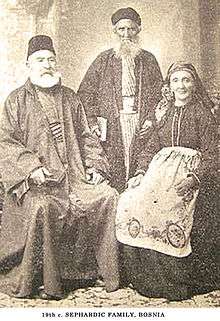
As Joseph Perez pointed out, "In 1492 the story of Spanish Judaism ends, which will only lead to an underground existence, always threatened by the Spanish Inquisition and the suspicion of a public opinion that saw In Jews, Judaizers and even sincere converts to natural enemies of Catholicism and Spanish idiosyncrasy, as understood and imposed by some ecclesiastical and intellectual leaders, in an attitude that bordered on racism."[92]
Historic accounts of the numbers of Jews who left Spain were based on speculation, and some aspects were exaggerated by early accounts and historians: Juan de Mariana speaks of 800,000 people, and Don Isaac Abravanel of 300,000. While few reliable statistics exist for the expulsion, modern estimates by scholars from the University of Barcelona estimated the number of Sephardic Jews at the 15th Century at 400,000 out of a total population of approximately 7.5 people in all of Spain, out of whom about half (at least 200,000[93][94]) or slightly more (300,000) remained in Iberia as Conversos;[95] others who tried to estimate the Jews' demographics based on tax returns and population estimates of communities are much lower, with Kamen stating that, of a population of approximately 80,000 Jews and 200,000 conversos, about 40,000 emigrated.[96] Another approximately 50,000 Jews received a Christian baptism so as to remain in Spain; many secretly kept some of their Jewish traditions and thus becoming the target of the Inquisition.[97] The Jews of the kingdom of Castile emigrated mainly to Portugal (where the entire community was forcibly converted in 1497) and to North Africa. The Jews of the kingdom of Aragon fled to other Christian areas including Italy, rather than to Muslim lands as is often assumed.[98] Although the vast majority of conversos simply assimilated into the Catholic dominant culture, a minority continued to practice Judaism in secret, gradually migrated throughout Europe, North Africa, and the Ottoman Empire, mainly to areas where Sephardic communities were already present as a result of the Alhambra Decree.[99]
The situation of those who returned was regularized with an order of November 10. 1492, in which it was established that civil and ecclesiastical authorities had to be witnesses to baptism, and in the event that they had been baptized before returning, evidence and testimonials that confirm it. They were also able to recover all their goods for the same price at which they had sold them. Returns are documented at least until 1499. On the other hand, a provision of the Royal Council of October 24, 1493, determined harsh sanctions for those who reviled these new Christians - calling them "transgressors," for example.[100]
As for the economic impact of the expulsion, it seems to be ruled out that it was a hard setback and stopped the birth of capitalism, which would be one of the causes of the decline of Spain. As Joseph Perez has pointed out, "in view of the published literature on taxation and economic activities, there is no doubt that the Jews were no longer a source of relevant wealth, neither as bankers nor as renters nor as merchants who developed the expulsion of the Jews produced problems at the local level but not a national catastrophe. It is unreasonable to attribute to that event the decadence of Spain and its supposed inability to adapt to the transformations of the modern world. What we now know shows that sixteenth-century Spain was not precisely an economically backward nation. [....] In strictly demographic and economic terms, and apart from human aspects, the expulsion did not imply for Spain any substantial deterioration, but only a temporary crisis Quickly overtaken."[101]
A copy of the Amsterdam Gazette published in the Netherlands on September 12, 1672. The Hebrews of Amsterdam printed a newspaper showing the interest of the Jewish community in what was happening at that time in Madrid and , It also read the news in Spanish - after 180 years of being expelled from its ancestral soil (1492).[102] Document preserved and exhibited in Beth Hatefutsoth, Nahum Goldmann Museum and House of the Diasporas, University of Tel Aviv, State of Israel.
The Sephardic diaspora and the Jewish identity continuity
Most of the expelled Jews settled in North Africa and in the Ottoman Empire.
In North Africa, those who went to the Fez kingdom suffered all kinds of ill-treatment and were plundered, even by the Jews who had lived there for a long time. Those who fought the best were those who settled in the territories of the Ottoman Empire, both in North Africa and in the Middle East, as in the Balkans and the Republic of Ragusa, after having passed by Italy. The sultan gave orders to welcome and his successor Soliman the Magnificent exclaimed on one occasion referring to King Ferdinand: "You call him king who impoverishes his states to enrich mine?" This same sultan commented to the ambassador sent by Carlos V who marveled that "they had cast the Jews of Castile, because it was to throw the wealth."[103]
As some Jews identified Spain and the Iberian Peninsula with the biblical Sepharad, the Jews expelled by the Catholic monarchs took or received the name of Sephardi. These, in addition to their religion, also kept many of their ancestral customs, and in particular have preserved the use of the Spanish language, a language which, of course, is not exactly what was spoken in fifteenth-century Spain: like any living language, it evolved and suffered the passage of time, notable alterations, although the structures and essential characteristics remained those of the Castilian late medieval. [...] The Sephardi never forgot the land of their parents, sheltering for her mixed feelings: on the one hand, the resentment for the tragic one's events of 1492, on the other hand, walking the time, the nostalgia of the lost homeland ...".[104]
About judeoespañol as a socio-cultural and identity phenomenon, Garcia-Pelayo and Gross wrote in the twentieth century:
It is said of the Jews expelled from Spain in the s. XV and that preserve in the East the language and the Spanish traditions. The expulsion of the Jews [...] sent a large number of families out of the Iberian Peninsula, mainly from Andalusia and Castile, to settle in the eastern Mediterranean countries dominated by the Turks, where they formed colonies which have survived to this day, especially in Egypt, Algeria, Morocco, Turkey, Greece, Bulgaria [...]. These families, generally composed of Sephardic elements of good social standing, have maintained their religion, traditions, language, and even their own literature for four and a half centuries. The Spanish that they transported, the one of Castile and Andalusia of ends of century XV, removed from all contact with the one of the Peninsula, has not participated in the evolution undergone by the one of Spain and Spanish colonial America. His phonetics presents some archaic but not degenerate forms; Its vocabulary offers countless Hebrew, Greek, Italian, Arabic, Turkish, according to the countries of residence.[105]
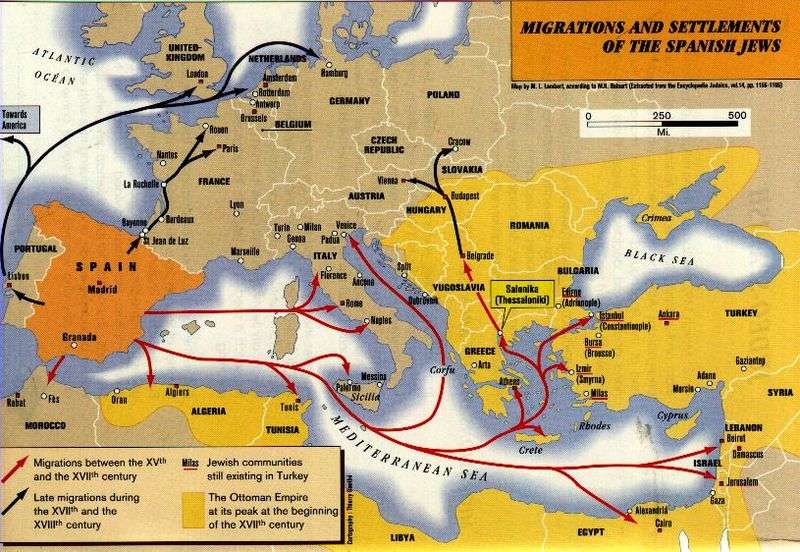
References
Notes
- Crypto-Judaism was not punished: "Certainly not because of tolerance or indifference, but because they lacked the appropriate legal instruments in order to define it as a crime." "No, por cierto, por tolerancia o indiferencia, sino porque se carecía de instrumentos jurídicos apropiados para caracterizar este tipo de delito. "[44]
- Friar Alonso De Ojeda: this is not Alonso de Ojeda, Spanish navigator and conquistador, but a close relative of his with the same name.
- Tribunal of the Inquisition: officially, "Tribunal of the Holy Office of the Inquisition" (Spanish: Tribunal del Santo Oficio de la Inquisición) normally known in English as the Spanish Inquisition.
Footnotes
- "The Edict of Expulsion of the Jews - 1492 Spain". www.sephardicstudies.org. Retrieved 2017-06-27.
- Perez (2012, p. 17)
- Gerber, Jane (1994). The Jews of Spain: A History of the Sephardic Experience. New York: The Free Press. pp. 1–144. ISBN 978-0029115749.
- Pérez, Joseph (2007). History of a Tragedy: The Expulsion of the Jews from Spain. Translated by Hochroth, Lysa. University of Illinois Press. ISBN 9780252031410.
- https://brewminate.com/jewish-migration-from-1500-to-the-20th-century/
- https://web2.ph.utexas.edu/~faraggi/faraggi.html
- "1492 Ban on Jews Is Voided by Spain", The New York Times, Dec. 17, 1968
- "Sephardic Jews eager to apply for Spanish citizenship", Washington Post, Feb. 17, 2014
- "1492 and all that", The Economist, Feb. 22, 2014
- Stavans, Ilan (2014-04-01). "Repatriating Spain's Jews". The New York Times. ISSN 0362-4331. Retrieved 2017-06-27.
- The Spanish Offer for Citizenship to Descendants of Sephardic Jews Has Ended, 130,000 requests for citizenship were made, Ofer Aderet, Haaretz, October 2nd, 2019.
- Lewis, Bernard W (1984). The Jews of Islam. Princeton University Press
- Darío Fernández-Morera (2016). The Myth of the Andalusian Paradise: Muslims, Christians, and Jews under Islamic Rule in Medieval Spain. Intercollegiate Studies Institute
- Cohen, Mark R. (October 1995). Under Crescent and Cross. Princeton University Press. ISBN 0-691-01082-X.
- Valdeón Baruque (2007, p. 98)
- Cailleaux, Christophe (2013). "Chrétiens, juifs et musulmans dans l'Espagne médiévale. La convivencia et autres mythes historiographiques". Cahiers de la Méditerranée (86). ISSN 1773-0201.
- Kamen (2011, p. 12)
- Kamen (2011, pp. 11; 16)
- Pérez (2012, pp. 10–11)«Los judíos, perseguidos, hallaron refugio en los reinos cristianos del norte, donde fueron bien acogidos por los príncipes porque procedían de un país –Al-Ándalus- cuya civilización era por aquel entonces muy superior a la de la España cristiana, porque hablaban árabe, porque conocían la organización política, económica y social de los territorios musulmanes y porque dominaban las técnicas comerciales más avanzadas».
- Pérez (2012, pp. 12–13)
- Pérez (2012, pp. 13–15)
- Pérez (2012, p. 15)
- Kamen (2011, p. 17)
- Perez (2012, pp. 16–17)
- Kamen (2011, p. 17)
- Perez (2012, p. 17)
- Perez (2009, p. 138)
- Kamen (2011, p. 19)
- Perez, 2009 & pp. 138; 164-165
- Pérez (2009, pp. 139–140)
- Pérez (2009, pp. 165–167)
- Pérez (2009, p. 168)
- Pérez (2009, p. 168)
- Pérez (2009, pp. 168–169)
- Pérez (2009, p. 174)
- Pérez (2009, pp. 169–170)
- Perez (2009, pp. 170–171)
- Kamen (2011, pp. 17–18)
- Pérez (2012, pp. 19–20)
- Kamen (2011, p. 35)
- Pérez (2012, pp. 20–21)"The rich are hated because they are safe from hunger and disease; traders are accused of storing wheat to cause prices to rise; the houses of one and the other are looted."
- Kamen (2011, pp. 44–46)"Anyone who does not adapt to the rest of the community will be I saw as "Jew." Manuel Rodríguez, alchemist of Soria in the 1470’s, disdained the official religion, but the parish priest described him as "the wisest men in the world in all things." Precisely for this reason he was reputed, according to the testimony of an official, to be "Jewish"
- Perez (2012, pp. 24–25)
- Perez (2012, pp. 26–27)
- Pérez (2012, p. 25)
- Pérez (2009, p. 171)
- Pérez (2012, pp. 26–27)
- Pérez (2012, pp. 21–22)
- Perez (2009, p. 175)}
- Pérez (2009, pp. 176–178)
- Valdeón Baruque (2007, p. 92)
- Valdeón Baruque (2007, p. 92)
- Valdeón Baruque (2007, p. 94)
- Pérez (2009, p. 178)
- Pérez (2009, p. 181)
- Pérez (2009, pp. 171–172)
- Pérez (2009, p. 182)
- Valdeón Baruque (2007, p. 93)
- Rumeu de Armas, Antonio. Consejo Superior de Investigaciones Científicas (ed.). New light on the Santa Fe capitulations of 1492 between the Catholic Monarchs and Christopher Columbus: institutional and diplomatic study. pp. 138–141. ISBN 9788400059613.
- Valdeón Baruque (2007, p. 101)
- Pérez (2009, pp. 185–186)
- Pérez (2009, p. 187)
- Perez, 2009 & pp. 187-188
- Perez (2009, p. 188)
- Perez (2009, p. 189)
- Suárez Fernández (2012, p. 415)
- Pérez (2013, p. 112)
- Pérez (2013, p. 111)
- Pérez (2013, p. 112)
- Pérez (2013, pp. 112–113)
- Pérez (2013, pp. 113–114)
- Valdeón Baruque (2007, p. 102)
- Pérez (2013, p. 114)
- Pérez (2013, p. 114)
- Pérez (2009, p. 188)
- Suárez Fernández (2012, p. 414)
- Pérez (2009, p. 188)
- Suárez Fernández (2012, p. 414)
- Suárez Fernández (2012, p. 415)
- Pérez (2009, p. 188)
- Valdeón Baruque (2007, pp. 99–100)
- Pérez (2013, pp. 117–118; 120-)
- Pérez (2013, pp. 124–125)
- Pérez (2013, p. 8)
- Valdeón Baruque (2007, pp. 89; 99)
- Pérez (2013, pp. 136–137)
- Valdeón Baruque (2007, p. 101)
- Pérez (2013, pp. 125–126)
- Pérez (2013, p. 124)
- Pérez (2013, pp. 128–129)
- Pérez (2013, pp. 129–132)
- Pérez (2013, p. 117)
- Gerber J : The Jews of Spain: A History of the Sephardic Experience, 1st ed. New York: Free Press, 1994.
- Bedford, F. Sephardic signature in haplogroup T mitochondrial DNA. Eur J Hum Genet 20, 441–448 (2012) doi:10.1038/ejhg.2011.200
- Genetic analysis of Sephardic ancestry in the Iberian Peninsula; Department of Evolutionary Biology, Ecology and Environmental Sciences and Biodiversity, University of Barcelona.
- Kamen (1998), pp. 29–31
- Wolf, A (1909). Life of Spinoza (Spinoza's Short Treatise on God, Man and his Well Being. London: Adam and Charles Black. pp. 4–5.
- Kamen (1998), p. 24
- Murphy, Cullen (2012). God's jury : the Inquisition and the making of the modern world. Boston: Houghton Mifflin Harcourt. p. 75. ISBN 978-0-618-09156-0.
- Pérez (2013, p. 115)
- Pérez (2013, pp. 118–120)
- La historia de los judíos en Sefarad (hebreo: España) se remonta a los tiempos de la Antigüedad e involucra a los súbditos del rey Salomón y a otros tantos exiliados del Reino de Judá (Toledo, Sinagoga del Tránsito, La vida judía en Sefarad, noviembre 1991—enero 1992; publicación del Ministerio de Cultura de España, pp. 19-20).
- Perez (2013)
- Pérez (2013, p. 117)
- Ramón García-Pelayo y Gross, Pequeño Larousse Ilustrado, Buenos Aires y México: Larousse, 1977, pp. 603-604.
Bibliography
- Kamen, Henry (2011). Criticism (ed.). The Spanish Inquisition. A historical review (3rd ed.). Barcelona. ISBN 978-84-9892-198-4.
- Pérez, Joseph (2009). Marcial Pons (ed.). The Jews in Spain. Madrid. ISBN 84-96467 -03-1.
- Brief history of the Inquisition in Spain. Barcelona. 2009. ISBN 978 -84-08-00695-4.
- Perez, Joseph (2007). Criticism (ed.). History of a tragedy. The expulsion of the Jews from Spain. Barcelona. ISBN 978-84-08-05538-9.
- Suárez Fernández, Luis (2012). Ariel (ed.). The expulsion of the Jews. A European problem. Barcelona. ISBN 978-84-344-0025-2.
- Editions of The University of Castilla-La Mancha, ed. (2007). "The reign of the Catholic Monarchs. Crucial time of Spanish anti-Judaism". Antimemitism in Spain. Cuenca: Gonzalo Álvarez Chillida and Ricardo Izquierdo Benito. ISBN 978-84-8427-471-1.



